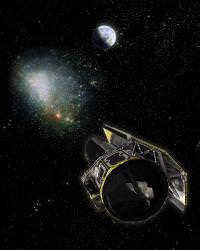A clever trick has enabled NASA’s Spitzer Space Telescope to calculate the distance to a distant object, confirming that it’s part of our Milky Way. An even more intriguing finding is that the object is probably a binary pair of black holes, orbiting one another – an extremely rare thing to see.
The Spitzer Space Telescope is the only space telescope that orbits the Sun behind the Earth. It’s already 70 million km (40 million miles), and it’s drifting further away every year. This distance between Spitzer and the Earth allows astronomers to look at an object from two different perspectives. Just like our two eyes give us depth perception, two telescopes can measure the distance to an object.
Astronomers noticed that something was causing a star to brighten. The speed and intensity of this brightening matched a gravitational lensing event, where a foreground object’s gravity focuses the light from a more distant star. They imaged the lensing event from here on Earth, but they also called Spitzer into duty to watch as well. Data from the two sources were combined together to determine that the lensing object is inside our galactic halo, and therefore part of its mass.
The light curve of the gravitational lens has led the researchers to believe that they’re looking at two compact objects orbiting one another, quite possibly a binary pair of black holes. It’s also possible that it’s just a pair of regular stars in a neighbouring, satellite galaxy.
Original Source: Spitzer News Release


Astronomical pairs of bodies of any kind do NOT orbit one another but simply both entities orbit their common center of mass. This is not orbiting one another.
Hello! illinois breast augmentation surgeon